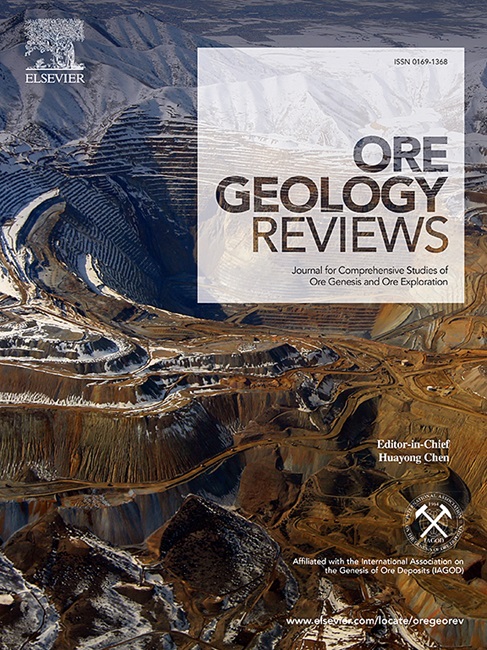Apatite and zircon compositions as petrogenetic and metallogenic indicators for late Ordovician porphyries in the Songshunangou gold district, North Qilian orogenic belt (China)
IF 3.2
2区 地球科学
Q1 GEOLOGY
引用次数: 0
Abstract
To elucidate the factors that control Au mineralization in porphyry systems, we present new whole-rock and mineral (apatite, zircon) chemical data on fertile quartz-dioritic porphyries (QDP) and barren granodioritic porphyries (GDP) from the Songshunangou gold district in the North Qilian orogenic belt, China. High Sr/Y ratios and the presence of ubiquitous hornblende phenocrysts, as well as “gull-wing” whole-rock rare earth element (REE) patterns, indicate that magmatic fractionation of hornblende was the main process that accounted for the formation of fertile and barren magma batches. Mineral chemistry of zircon (i.e., Ce/Sm, Yb/Gd, Th/U, and Hf/Y ratios) indicates that the development of the GDP magma was likely controlled by hornblende, apatite, and titanite fractionation, whereas hornblende-dominated fractional crystallization explains the origin of the QDP magma. Application of zircon oxy-barometry yielded moderate oxidation states for both magmas, with ΔFMQ − 0.25 to ΔFMQ + 2.34 (av. ΔFMQ + 0.33) for the GDP, and ΔFMQ − 0.25 to ΔFMQ + 0.72 (av. ΔFMQ + 0.27) for the QDP, which are favorable for the mobilization and transport of Au. Whole-rock and apatite Sr/Y ratios, combined with the (Ce/Nd)/Y and (10000 × Eu/Eu*)/Y ratios of zircon, support that higher H2O contents were associated with the QDP magma if compared to the GDP. Apatite in the GDP has low XF/XCl ratios of 2.99–11.33, indicating crystallization from a volatile-undersaturated magma, with average melt Cl concentrations of 0.35 wt%. Apatite in the QDP with low XF/XCl ratios (≤7.78) is interpreted to have crystallized from volatile-undersaturated magma with higher melt Cl concentrations (av. 0.42 wt%), whereas apatite with high XF/XCl ratios (11.53–59.80) is interpreted to have crystallized after fluid exsolution. Our results confirm that moderate oxygen fugacity, high H2O and Cl as well as early fluid exsolution, are prerequisites for porphyry Au mineralization.

求助全文
约1分钟内获得全文
求助全文
来源期刊

Ore Geology Reviews
地学-地质学
CiteScore
6.50
自引率
27.30%
发文量
546
审稿时长
22.9 weeks
期刊介绍:
Ore Geology Reviews aims to familiarize all earth scientists with recent advances in a number of interconnected disciplines related to the study of, and search for, ore deposits. The reviews range from brief to longer contributions, but the journal preferentially publishes manuscripts that fill the niche between the commonly shorter journal articles and the comprehensive book coverages, and thus has a special appeal to many authors and readers.
 求助内容:
求助内容: 应助结果提醒方式:
应助结果提醒方式:


